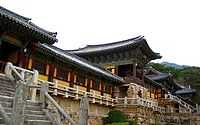Jinhan confederacy
| Jinhan confederacy | |
| Hangul | 진한 |
|---|---|
| Hanja | 辰韓 |
| Revised Romanization | Jinhan |
| McCune–Reischauer | Chinhan |
Jinhan was a loose confederacy of chiefdoms that existed from around the 1st century BC to the 4th century AD in the southern Korean peninsula, to the east of the Nakdong River valley, Gyeongsang Province. Jinhan was one of the Samhan (or "Three Hans"), along with Byeonhan and Mahan. Apparently descending from the Jin state of southern Korea, Jinhan was absorbed by the later Silla, one of the Three Kingdoms of Korea.
History
Part of a series on the |
||||||||
|---|---|---|---|---|---|---|---|---|
| History of Korea | ||||||||
 | ||||||||
| Prehistory | ||||||||
| Ancient | ||||||||
| Proto–Three Kingdoms | ||||||||
| Three Kingdoms | ||||||||
|
||||||||
| North and South States | ||||||||
|
||||||||
| Later Three Kingdoms | ||||||||
|
||||||||
| Unitary dynastic period | ||||||||
|
||||||||
| Colonial period | ||||||||
|
||||||||
| Division of Korea | ||||||||
|
||||||||
| By topic | ||||||||
| Timeline | ||||||||
| Korea portal | ||||||||
Jinhan, like the other Samhan confederacies, arose out of the confusion and migration following the fall of Gojoseon in 108 BC.
Culture
Its relation to the earlier state of Jin is not clear, although the contemporary Chinese chronicle San Guo Zhi alleges that Jinhan was identical with Jin (while another record describes Jin as the predecessor of the Samhan as a whole). Jinhan and Byeonhan shared essentially the same culture, with varying religious customs, and apparently were not separated by a clear boundary.
The people claimed they were descendants of Qin dynasty migrants, fleeing Qin's force labor policies moved to the Mahan confederacy which give them the east land. The confederacy was also called Qinhan (秦韓). As immigrants, the kings might be Mahan people according to several historical books of China. But there is no further archeological evidences to prove this is true.
Statelets
According to the San Guo Zhi, Jinhan consisted of 12 statelets of 600 to 5000 families each divided from 6 statelets:
- Saro (사로국, 斯盧國), most powerful state in Jinhan, it is also called Seorabeol. In 503, Saro state renamed itself "Silla".
- Gijeo (기저국, 己柢國), present-day Andong.
- Bulsa (불사국, 不斯國), present-day Changnyeong.
- Geun-gi (근기국, 勤耆國), present-day Pohang or Cheongdo.
- Nanmirimidong (난미리미동국, 難彌理彌凍國), present-day Miryang. It is also called "Mirimidong".
- Yeomhae (염해국, 冉奚國), present-day Ulsan.
- Gunmi (군미국, 軍彌國), present-day Sacheon.
- Yeodam (여담국, 如湛國), present-day Gunwi.
- Horo (호로국, 戶路國), present-day Sangju.
- Juseon (주선국, 州鮮國), present-day Gyeongsan.
- Mayeon (마연국, 馬延國), present-day Miryang.
- U-yu (우유국, 優由國), present-day Cheongdo or Yeongdeok.
According to Samguk Sagi, the Silla Kingdom (around present-day Gyeongju), was founded by Bak Hyeokgeose in 57 BC, who united the six clans of Jinhan under his rule. The records are sparse and conflicting regarding the relationship of the names Jinhan, Saro, Seorabeol, and the later Silla kingdom.
We know little of the daily life of Jinhan people. The religion appears to have been shamanistic, and to have played an important role in politics as well. Agriculture was heavily dominated by rice, but also included substantial rearing of livestock including horses, cattle, and chickens.
Location
Most theories indicate that Jinhan was located in the area later occupied by the Silla kingdom: the Gyeongju Basin and adjacent Sea of Japan coast. It would have been neighbored by the Byeonhan confederacy on the southwest, and by the much larger Mahan confederacy on the west. On the north it would have been bounded by the Chinese commanderies and the small coastal state of Dongye. However, some scholars place Jinhan in the Han River valley, bounded by Mahan on the north and Byeonhan on the south.
See also
- List of Korea-related topics